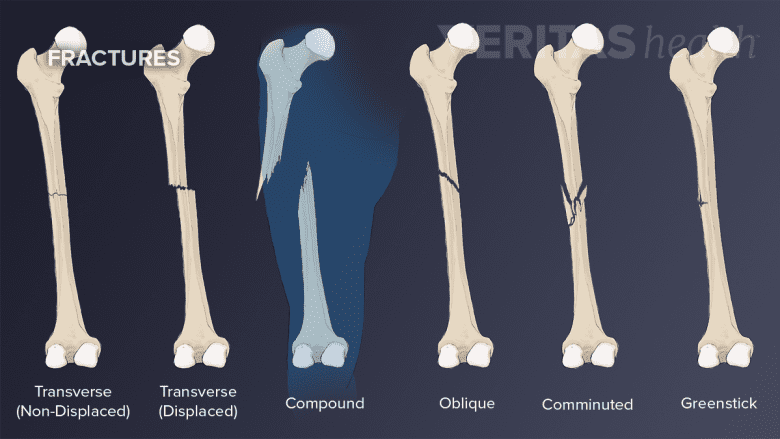It may come as a surprise, but a broken bone and a fractured bone are the same thing. A fracture occurs when an outside force is too great for a bone to handle. Although generally rigid, bones can weaken over time and become more susceptible to fracturing.
Fractures may occur lengthwise, crosswise, or in multiple pieces. Similarly, the underlying causes of bone breaks varies.
In This Article:
- Bone Break vs. Fracture
- Signs, Symptoms, and Treatment for Bone Fractures
Different Types of Bone Fractures
Fractures are classified by how the bone breaks. The most common fractures are:

The most common fractures are illustrated here along the femur.
- Compound (open) fracture. The bone may pierce the skin at the time of the fracture.
- Transverse fracture. When the bone breaks in a horizontal line.
- Oblique fracture. When the bone has a diagonal or angled break.
- Comminuted fracture. This means the bone has been shattered into 3 or more pieces.
- Greenstick fracture. When the bone bends and cracks but does not fully break. This is commonly seen in children because their bones are softer and more flexible than adults.
A fracture may be further classified by whether or not the broken pieces of bone are aligned:
- Non-displaced fracture. When the broken parts of the bone are aligned.
- Displaced fracture. When the broken parts of the bone are not aligned.
In addition, a fracture may be labeled stable or unstable. These clinical terms refer to whether the bone pieces can be easily disturbed and moved out of place. When a fracture is labeled unstable, it means that the two pieces of bone that are broken will not be able to withstand normal weight-bearing or natural physiologic forces.
The type and severity of a fracture will influence the treatment plan.
What Causes a Bone Fracture?
A bone fracture typically occurs for one of 3 reasons.
- Bone stress. Repetitive use, such as frequent long-distance running, can fatigue the muscles that support the skeletal system. When muscles are fatigued bones experience more stress, which can cause tiny breaks. These breaks are sometimes called stress or hairline fractures.
- Outside force. Too much force can cause a break if it exceeds the strength of the bone. Car accidents, contact sports, such as football, and falls often cause bone fractures.
- Weakened bone. When a bone is weakened from and underlying condition, such as osteoporosis or infection, it can cause it to break more easily than if it were healthy.
A fracture can occur for more than one reason (for example, weakened bone and outside force).

